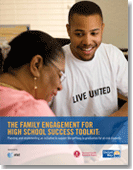The Harvard Family Research Project separated from the Harvard Graduate School of Education to become the Global Family Research Project as of January 1, 2017. It is no longer affiliated with Harvard University.

|
November 2011 The Family Engagement for High School Success Toolkit: Planning and implementing an initiative to support the pathway to graduation for at-risk studentsUnited Way Worldwide, Harvard Family Research Project |
Article Information
- Full Text (HTML)
- Full Text (PDF: 1228 kb)
A two-part webinar series designed to help you make the most of the toolkit
- Webinar 1: Family Engagement for High School Success: Creating a Plan of Action
Wednesday, December 7, 2011, 1:00-2:00 p.m. EST
View the webinar archive. - Webinar 2: Family Engagement for High School Success: Implementation Successes and Challenges
Thursday, December 8, 2011, 1:00-2:00 p.m. EST
View the webinar archive.
The Family Engagement for High School Success Toolkit is designed to support at-risk high school students by engaging families, schools, and the community. Created in a joint effort by United Way Worldwide (UWW) and Harvard Family Research Project (HFRP) as part of the Family Engagement for High School Success (FEHS) initiative, the toolkit has two parts:
- Part 1 focuses on the comprehensive planning that goes into the development of a family engagement initiative.
- Part 2 focuses on the early implementation process.
ABOUT THE FEHS INITIATIVE
One fourth of all 9th graders in the United States will not graduate from high school within four years,1 despite the fact that the 21st century workplace requires more advanced knowledge and skills than ever before. Recognizing the need for a comprehensive strategy to keep teens in school and ensure that they graduate prepared for the future, UWW, in partnership with HFRP and sponsored by AT&T, launched the Family Engagement for High School Success initiative. This initiative offered an invaluable opportunity to pioneer strategies for bringing families, school leaders, community partners, and students together to build a network of supports to help keep students on the path to high school graduation, college or advanced training, and successful lives beyond.
ABOUT THE TOOLKIT
The Family Engagement for High School Success Toolkit: Planning and implementing an initiative to support the pathway to graduation for at-risk students, highlights the lessons learned from a planning process that tasked 15 local United Way “pilot sites” with bringing together schools, community organizations, families, and other stakeholders to a develop a comprehensive family engagement initiative. With support from the UWW and HFRP, these pilot sites adopted outcome-focused approaches with the aim of designing family engagement strategies to remove obstacles to engagement, and, ultimately, build stronger connections between families and schools. From this careful planning process the pilot sites and their partners in the community developed implementation plans with strong potential for success.
The Family Engagement for High School Success Toolkit will help local United Way chapters, nonprofits, schools, and other community organizations:
- Identify how to spot ninth graders who are at risk of dropping out, considering factors such as attendance, behavior, and academic performance.
- Enlist and enroll the right partners and work creatively to reach parents of at-risk kids.
- Work with parents, schools, and partners to apply research-based strategies and promising practices to get at-risk students back on track to graduate from high school.
It is important to note that this toolkit is based on an initiative that deliberately focused on improving academic outcomes for students at high risk of not graduating from high school, yet the principles contained in the toolkit are applicable to a wide array of K–12 family engagement initiatives. While the toolkit was created for larger community organizations such as United Way chapters, schools and smaller nonprofits will find the planning and implementation guidance useful as they look to connect with other organizations that can contribute to the development of a comprehensive family engagement initiative.
The toolkit reflects a set of guiding principles:
- Family engagement is fully integrated into dropout prevention and high school graduation efforts.
- Family engagement is shared and co-constructed, necessitating the participation of students and families in designing family engagement strategies.
- Communities are committed to a data-driven process and to evaluation for learning and accountability.
- Schools and communities are working to address the obstacles to family engagement—including those related to social disadvantage and cultural differences—and providing meaningful opportunities for families to take action.
RELATED RESOURCES
Download the Focal Family Participation Spreadsheet (from Appendix C, pages 100–101 of the Toolkit):
- As a PDF (PDF, 45 KB)
- As an Excel spreadsheet (XLS, 45 KB)
1. Balfanz, R., Bridgeland, J., Moore, L., & Horning Fox, J. (2010). Building a grad nation: Progress and challenges in ending the high school dropout epidemic. Washington, DC: Civic Enterprises, Everyone Graduates Center at John Hopkins University, & America’s Promise Alliance.
